Summary
Revista Brasileira de Ginecologia e Obstetrícia. 2010;32(10):491-496
DOI 10.1590/S0100-72032010001000004
PURPOSE: to evaluate painful sensitivity and factors involved in producing papillary fluid suitable for cytological analysis by means of automated collection. METHODS: we selected 50 asymptomatic women without a personal or family history of breast cancer, outside the pregnancy and childbirth cycle in order to collect papillary fluid by the automated system. We recorded and related to the production of papillary fluid patient age, smoking habit, previous breast surgery, parity, breastfeeding, menopausal status and age at menarche. All material collected was fixed in appropriate place, and sent separately for cytological analysis. The painful sensitivity of the collection procedure was assessed using the Borg Category-Ratio Scale (CR10 Scale). RESULTS: patient age ranged from 22 to 59 years, mean 41.6±8.6 years. Of the 50 patients, 20 (40%) showed no papillary fluid suitable for analysis in the breasts. In those patients from whom appropriate fluid was obtained for analysis of papillary cytology, parity was inversely related to the ability to obtain suitable cell samples with a level of statistical significance of p=0.035, OR=0.0032 (95%CI=0.0001-0.1388). Regarding soreness, the exam was well tolerated. CONCLUSIONS: the automated method of fluid collection for analysis of papillary cytology was well tolerated by the women; thus producing analyzable material in 60% of cases, a rate was inversely related to parity.
Summary
Revista Brasileira de Ginecologia e Obstetrícia. 2010;32(10):486-490
DOI 10.1590/S0100-72032010001000003
PURPOSE: to determine the efficacy of intraoperative injection of Dextran-500-99m-technetium (Tc) for the identification of the sentinel lymph node (SLN) in breast cancer and analyze time to label the SLN in the axillary region. METHODS: a prospective study between April 2008 and June 2009, which included 74 sentinel lymph node biopsies (SLNB) in patients with breast cancer in stages T1N0 and T2N0. After induction of anesthesia, 0.5 to 1.5 mCi of Dextran-500-99m-Tc filtered 0.22 µm in a volume of 5 mL was injected intraoperative using the subareolar technique for SLNB. After labeling with the radioisotope, 2 mL of patent blue was injected. The time elapsed between injection and the axillary hot spot, the in vivo and ex vivo counts of the hottest nodes, the background count, and the number of SLN identified were documented. Data were analyzed using descriptive statistics with SPSS program, version 18. RESULTS: we identified the SLN in 100% of cases. The rate of SLN identification with the probe was 98% (73/74 cases). In one case (1.35%) the SLN was labeled only with the blue dye. The mean dose of radioisotope injected was 0.97±0.22 mCi. The average time to label the SLN was 10.7 minutes (±5.7 min). We identified on average of 1.66 SLN labeled with the radioisotope. CONCLUSION: the procedure for SLN identification with an intraoperative injection of the radioisotope is oncologically safe and comfortable for the patient, providing agility to the surgical team.
Summary
Revista Brasileira de Ginecologia e Obstetrícia. 2010;32(6):293-297
DOI 10.1590/S0100-72032010000600007
The symptoms of ovarian tumor are not specific and a rare presentation of the tumor is as the content of an inguinal hernia. We reported a case of an 82-year-old woman, diagnosed with breast cancer and with a concomitant hypoecoic adnexal mass at the ecographic exam. The patient was treated with conservative breast surgery and laparotomy. A cystic-solid ovarian lesion was found inside the right inguinal canal. Frozen-section examination was negative for malignancy, and the anatomopathological analysis revealed a borderline ovarian tumor.

Summary
Revista Brasileira de Ginecologia e Obstetrícia. 2010;32(5):241-246
DOI 10.1590/S0100-72032010000500007
PURPOSE: to assess the knowledge, attitude and practice of breast self-examination (BSE) of women from the municipality of São Luís (MA), Brazil, and associated socio-demographic variables. METHODS: prospective and cross-sectional study, with conglomerate sampling, in which 552 women from 14 census sections of São Luís were included during the period from January to September 2003. The knowledge, attitude and practice (dependent variables) were evaluated by means of analysis of the responses of the women as "adequate" or "inadequate". The main independent variables were: age, schooling, family income and marital and menopausal status. The χ2 test was used to determine the association between categorical variables and the measurement of the crude/adjusted Odds Ratio (OR) after multivariate analysis by means of logistic regression. RESULTS: although 1/3 of the studied population did not know about BSE, the group of women who were informed about it showed adequate knowledge (60.9%), practice (59.5%) and attitude (90%). The family history of breast cancer (8.9%) was not associated with better knowledge and practice. The media (63.6%) was found to be important in disseminating information about BSE. After multivariate analysis, women with a partner (OR=1.9) presented more adequate knowledge; women older than 50 years (OR=11.7) had a better attitude towards BSE; women with more than five years of schooling (OR=2) and with a partner (OR=1.7) were associated with a more correct practice of BSE. CONCLUSION: most of the patients know and practice the BSE in São Luís and their attitude towards the procedure is extremely positive. There was a great participation of the media in the dissemination of information concerning BSE.
Summary
Revista Brasileira de Ginecologia e Obstetrícia. 2010;32(4):191-197
DOI 10.1590/S0100-72032010000400007
PURPOSE: to assess compliance with the recommendations for opportunistic breast cancer screening by mammography. METHODS: 460 women from the town of Taubaté, São Paulo, Brazil, were followed-up prospectively after the index mammography, 327 of them attended by the public health system and 133 by the private system. We evaluated the prevalence of mammography repetition, the adherence rates and predictive factors associated with the current recommendations of mammographic screening. The association of the outcomes with the independent variables was studied by obtaining the risk rates (RR) and the respective 95% confidence intervals (95%CI). The adjusted prevalence rates were calculated by the COX regression model. RESULTS: although more than 90% of the studied women repeated the mammography at least once, the rate of correct compliance with the recommendations of mammographic screening, with repetition of the procedure every 24 months, was low (about 30% of the study sample). The preditive factors associated with compliance with mammographic screening were related to the unequal access to public or private healthcare services (RR=1.77; 95%CI=1.26-2.48) and to previous screening (RR=3.07; 95%CI=1.86-5.08). CONCLUSION: we concluded that compliance with the recommendations of opportunistic mammographic screening for breast cancer was low in both studied population segments.

Summary
Revista Brasileira de Ginecologia e Obstetrícia. 2010;32(3):133-138
DOI 10.1590/S0100-72032010000300006
PURPOSE: to assess the influence of physiotherapy performed during radiotherapy (RT) on the quality of life (QL) of women under treatment for breast cancer. METHODS: this was a randomized clinical trial conducted on 55 women under RT treatment, 28 of whom were assigned to a group submitted to physiotherapy (PG) and 27 to the control group receiving no PG (CG). The physiotherapy technique used for PG was kinesiotherapy for the upper limbs using 19 exercises actively performed, with a series of ten rhythmic repetitions or stretching movements involving flexion, extension, abduction, adduction, internal and external shoulder rotation, separate or combined. QL was evaluated using the Functional Assessment of Cancer Therapy-Breast (FACT-B), at the beginning and at the end of RT and six months after the end of RT. The physiotherapy sessions were started concomitantly with RT, 90 days after surgery, on average. RESULTS: there was no difference between subgroups regarding the following subscales: physical well-being (p=0.8), social/family well-being (p=0.3), functional well-being (p=0.2) and breast subscale (p=0.2) at the three time points assessed. A comparison of the emotional subscale applied at the three evaluations demonstrated a better behavior of PG as compared to CG (p=0.01), with both groups presenting improvement on the breast subscale between the beginning and the end of RT (PG p=0.0004 and CG p=0.003). There was improvement in FACT-B scores at the end of RT in both groups (PG p=0.0006 and CG p=0.003). However, at the sixth month after RT, this improvement was maintained only in PG (p=0,005). QL assessed along time by the FACT B (p=0.004) and the Trial Outcome Index (TOI) (sums of the physical and functional well-being subscales and of the breast subscale) was better for PG (p=0.006). There was no evidence of negative effects associated with the exercises. CONCLUSIONS: the execution of exercises for the upper limbs was beneficial for QL during and six months after RT.
Summary
Revista Brasileira de Ginecologia e Obstetrícia. 2009;31(10):508-512
DOI 10.1590/S0100-72032009001000007
PURPOSE: to check epidemiological data from a breast diagnostic clinic. METHODS: mammographies from 35,041 patients were studied, within a period of 2 years and 7 months, from 2004 to 2006, 32,049 (91.5%) of them from screening, and 2,992 from symptomatic patients (8.5%). The calculated parameters were: detection rate of the screening patients, percentage of cancer among the symptomatic patients, rate of biopsy indication, percentage of minimal, in situ, and stage 0-1 carcinomas, recall rate, and predictive value of mammographies considered as abnormal and of biopsies' indications in screening patients. RESULTS: 228 diagnoses of breast cancer were made, 111 in screening patients (0.34% detection rate) and 117 in symptomatic patients (3.91% detection rate). The number of biopsies' recommendations among screening patients was 544 (1.7% of those patients). There were 28% of minimal carcinomas, 10% of in situ carcinomas and 93% of stage 0-1 carcinomas among the screening patients. Recall rate was 19%. Positivity of mammographies considered as abnormal (VPP1) was 1.65%. The rate of biopsies' positivity (VPP2) was 21.9%. CONCLUSIONS: this study brings important epidemiological data for the audit of mammographic screening, rare among us. Data have been analyzed as compared to what is recommended by the literature, the detection rate and the percentage of minimal and in situ carcinomas found being comparable to the established values, but with the VPP value lower than the ideal.